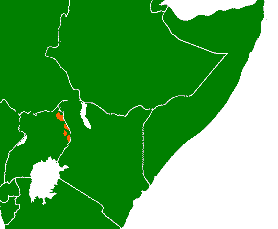Kuliak languages
| Kuliak | |
|---|---|
| Rub | |
| Geographic distribution |
Karamoja region, northeastern Uganda |
| Linguistic classification |
Nilo-Saharan?
|
| Proto-language | Proto-Kuliak |
| Subdivisions | |
| Glottolog | kuli1252 |
 | |
The Kuliak languages, also called the Rub languages, are a group of languages spoken by small relict communities in the mountainous Karamoja region of northeastern Uganda.
Nyang'i and Soo are moribund, with a handful of elderly speakers. However, Ik is vigorous and growing.
Word order in Kuliak languages is verb-initial.
Names
The Kuliak languages are also called the Rub languages by Ehret (1981), since Ehret reconstructed "Rub" to mean 'person' in Proto-Kuliak. He suggests that "Kuliak" may actually be a derogatory term used by neighboring Nilotic-speaking peoples to disparage Kuliak speakers as "poor," hence his preference for using Rub instead. However, Kuliak continues to be the most widely used name, and is preferred by Roger Blench, Terrill Schrock, Sam Beer and other linguists, who note that the name "Kuliak" is not perceived as offensive or pejorative by any Kuliak speakers.
Classification
Internal
Heine (1976) classifies the Kuliak languages as follows. According to Heine (1976), Soo and Nyang'i form a subgroup, Western Kuliak, while Ik stands by itself.
| Kuliak |
|
||||||||||||
According to Schrock (2015), Dorobo is a spurious language, is not a fourth Kuliak language, and may at most be a dialect of Ik.
External
Bender (1989) had classified the Kuliak languages within the Eastern Sudanic languages. Later, Bender (2000) revised this position by placing Kuliak as basal branch of Nilo-Saharan. Glottolog treats Kuliak as an independent language family and does not accept Nilo-Saharan as a valid language family.
Evolution
Blench notes that Kuliak languages do not have extensive internal diversity and clearly had a relatively recent common ancestor. There are many monosyllabic VC (vowel + consonant) lexical roots in Kuliak languages, which is typologically unusual among Nilo-Saharan languages and is more typical of some Australian languages such as Kunjen. Blench considers these VC roots to have cognates in other Nilo-Saharan languages, and suggests that the VC roots may have been eroded from earlier Nilo-Saharan roots that had initial consonants.
Bernd Heine (1976) has proposed a reconstruction of Proto-Kuliak.
Significant influences from Cushitic languages, and more recently Eastern Nilotic languages, are observable in the vocabulary and phonology of Kuliak languages. Blench notes that Kuliak appears to retain a core of non-Nilo-Saharan vocabulary, suggesting language shift from an indigenous language like that seen in Dahalo.
Numerals
Comparison of numerals in individual languages:
| Language | 1 | 2 | 3 | 4 | 5 | 6 | 7 | 8 | 9 | 10 |
|---|---|---|---|---|---|---|---|---|---|---|
| Ik (1) | kɔ̀nʊ̀kᵓ (lit: and it's one) | lèɓètsìn (lit: and it's two) | àɗìn (lit: and it's three) | tsʼàɡùsìn (lit: and it's four) | tùdìn (lit: and it's five) | tudini ńda kɛɗɪ kɔn (5+ 1) | tudini ńda kiɗi léɓetsᵉ (5+ 2) | tudini ńda kiɗi aɗ (5+ 3) | tudini ńda kiɗi tsʼaɡús (5+ 4) | tomín |
| Ik (2) | kɔnᵃ | léɓetsᵃ | aɗᵃ / aɗᵉ | tsʔaɡúsᵃ | túdᵉ | ńda-keɗi-kɔnᵃ (5+ 1) | ńda-kiɗi-léɓetsᵃ (5+ 2) | ńda-kiɗiá-aɗᵉ (5+ 3) | ńda-kiɗi-tsʔaɡúsᵃ (5+ 4) | tomín |
| Nyang'i | nardok | nɛʔɛc | iyʔɔn | nowʔe | tud | mɔk kan kapei | mɔk tomin | |||
| Soo (Tepes) (1) | nɛ́dɛ̀s | ínɛ̀'bɛ́c | ínì'jɔ̀n | ín'ùáʔ | íntùd | ˌíntùd ká ˈnɛ́dɛ̀s (5+ 1) | ˌíntùd ká ínɛ̀'bɛ̀c (5+ 2) | ˌíntùd ká ínì'jɔ́n (5+ 3) | ˌíntùd ká ínùáʔ (5+ 4) | mì'míɾínìk |
| Soo (Tepes) (2) | ɛdɛs | nɛbɛc | iyon | nowa | tuɗ | tuɗ ka nɪ ɛdɛs (5+ 1) | tuɗ ka nɪ nɛbɛc (5+ 2) | tuɗ ka nɪ iyon (5+ 3) | tuɗ ka nɪ nowa (5+ 4) | tuɗ en-ek iɠe (hand-PL all) |
See also
- List of Proto-Kuliak reconstructions (Wiktionary)